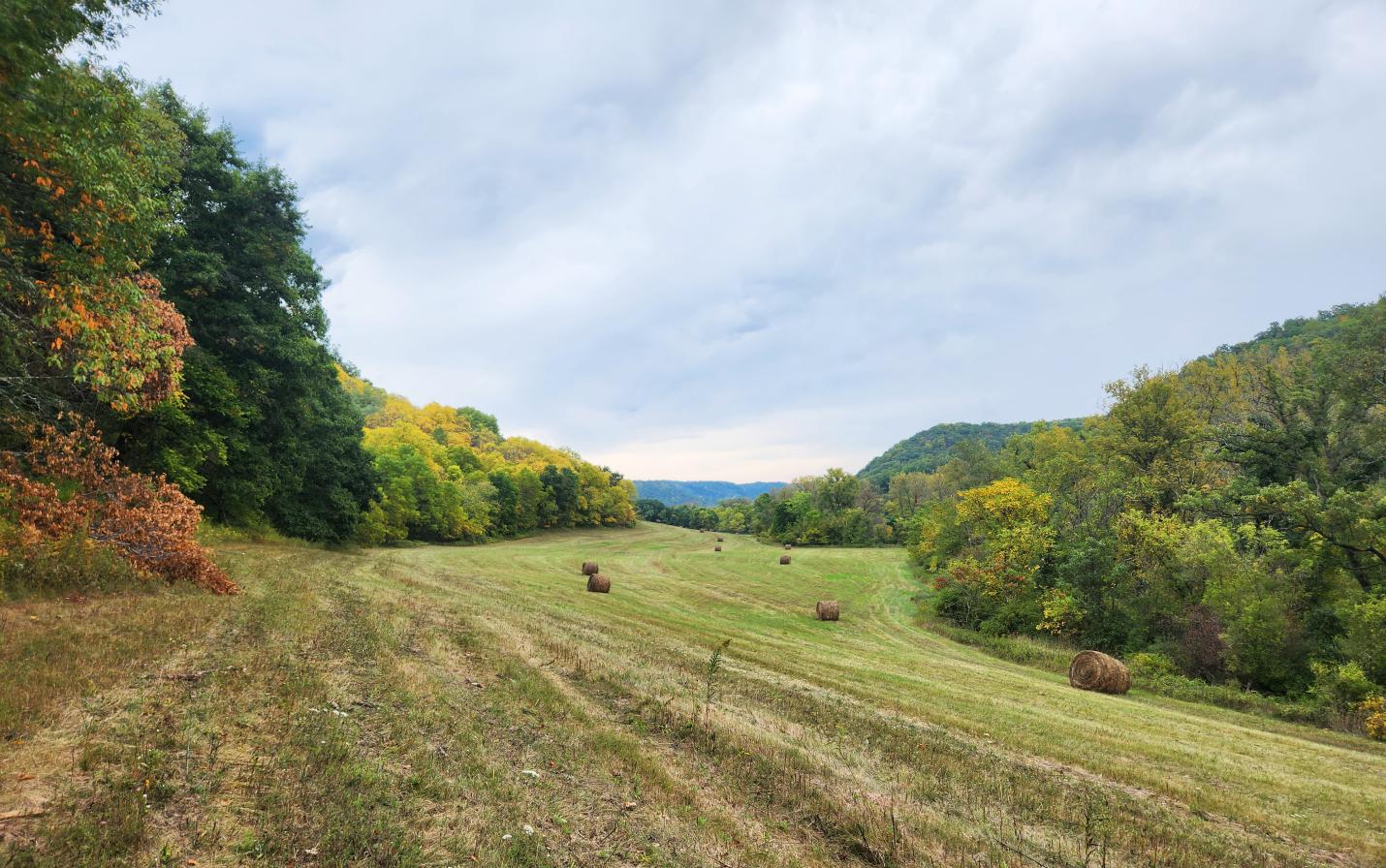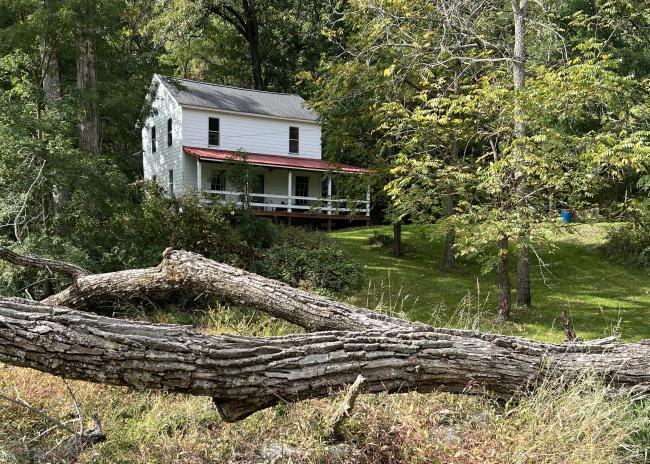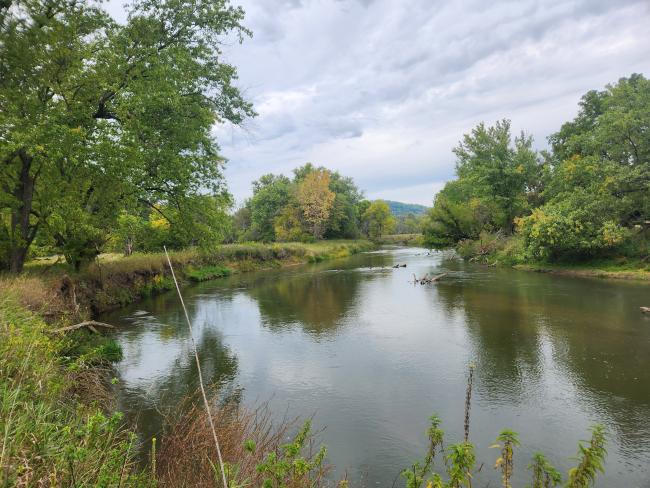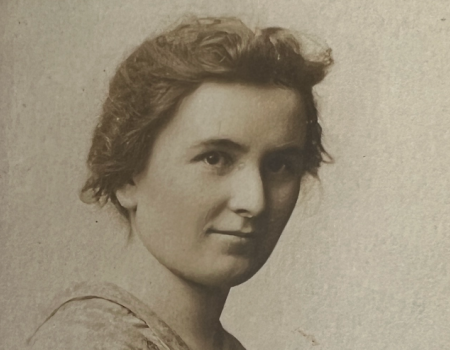
LA CROSSE, WI – The Twining Farm, a 345-acre historic homestead property along the west bank of Kickapoo River, just south of Gays Mills, Wisconsin, is now permanently conserved for the sake of the river, its native habitats, wildlife, and the communities that depend upon it. The well-known matriarch of the farm, Leita Twining Slayton (1898-1994), had strong feelings about its protection. John Slayton, Leita’s grandson, said it’s been in the family for nearly 170 years, and “Granny would be proud to see it conserved.” He signed the property into a conservation easement with Mississippi Valley Conservancy on November 30, 2023. John Slayton retains ownership of the private property which is now forever protected from subdivision and development.
Most everyone who lived in the town of Gays Mills during the 1900s is familiar with the Twining Farm and knew Leita Twining Slayton. If their grandfather didn’t fight in the Civil War with her grandfather, David Twining, then they likely knew him after the war as a well-respected farmer, lumberjack, mechanic, and gunsmith in Gays Mills. After growing up on the farm, David’s youngest grandchild, Leita, eventually came into legal possession of the land and took over managing its operations. “She focused on its timber, pasture, and tobacco crops – always caring for the land to give back,” said Kathy Fairchild, a friend and former assistant to Leita in managing the farm records.

Leita was an active community member and was honored at a convention of the Wisconsin Federation of Women’s Clubs for her years of service with community-based organizations and conservation projects. She was a single mother, after a divorce, and she taught home economics at the Gays Mills Public School for many years. All the while, she was successful in managing the farm with the help of a “hired man” who lived in the tiny tenant house. Sales from the farm included milk, timber, and tobacco.
According to her godson, John Gibbs, Leita was witty, sarcastic, well-read, and opinionated. On Sundays, the coffee pot was always on and she welcomed visitors, including her son’s friend Ben Logan, renowned author of “The Land Remembers.” Even those who didn’t necessarily see eye-to-eye with “Mrs. Slayton” on all matters liked and respected her and her many accomplishments. Gibbs recalled how in Leita’s later years a caretaker would stop by on his way in and out of town to stoke her huge basement stove, and she would reward him each day with a hot breakfast. “She was friendly and welcoming to a great many people,” said Gibbs.
Leita was also a preservationist and a conservationist. She was proud of her own heritage and she led the effort to create Log Cabin Heritage Park near the Gays Mills fairgrounds, where original log cabins from the area are relocated and protected. She was named Crawford County’s Outstanding Tree Farmer in 1988. She was also involved with a soil conservation project to mitigate the impacts of flooding along the Kickapoo River. Perhaps her greatest conservation legacy is the land where she lived and farmed which is now forever protected in her honor.
The conserved property falls within three separate high priority areas for conservation; the Lower Kickapoo River Wisconsin Important Bird Area, the Mississippi Valley Conservancy Kickapoo River Priority Area, and the Lower Kickapoo River Conservation Opportunity Area that was designated as being of “continental significance” according to the Wisconsin Wildlife Action Plan. Adjacent lands, protected by Mississippi Valley Conservancy, Wisconsin DNR, and The Prairie Enthusiasts, provide a corridor of over two thousand acres of protected habitat. The Conservancy nature preserve, Kickapoo Bottoms, is located just across the river from the newly conserved property.
Expanding protected corridors and protecting large blocks of high-quality habitat are an important theme in the Conservancy’s Strategic Plan. These corridors allow for wildlife movement, an important strategy in providing resilience to a changing climate. The Slayton property location along the Kickapoo River places it in one of the most unique and diverse assemblages of natural communities in Wisconsin. It includes a stunning array of diverse wooded blufflands, high-quality dry prairie and open grassland, springs, wetlands, and floodplain forest. The property provides excellent habitat for a variety of wildlife species and various pollinators.

The Slayton property plays an important role in protecting the quality of the Kickapoo Watershed. The property borders the Kickapoo River to the east for nearly a mile and also contains numerous springs, drainages, and wetlands. Land use on the property can have a direct impact on the Kickapoo River’s water quality, meaning sustainable and ecological land practices on the property are important to maintaining the river’s quality. The Slayton property’s wetlands and perennial vegetation along the Kickapoo also help prevent erosion, filter runoff, and play an important role in flood abatement, all while providing essential habitat for wildlife and scenic beauty for paddlers and other onlookers to enjoy.
This expanding corridor of conserved land is rich in game and non-game wildlife, according to John Motoviloff, Wisconsin R3 and Outreach Coordinator with Pheasants Forever, Inc. and Quail Forever. John and his wife live next door to the Slayton property, and he has fond memories of duck hunting in the Kickapoo Bottoms area. He also says that less intensive farming along the Kickapoo is resulting in cooler water and a gradually improving brook trout population. The Slayton property contributes to that trend.
In 1990, at the age of 92, Leita lived alone on the farm on which she was born, stating “I will be in this house as long as I live… Everything in my house has meaning to me. When I look at my antiques, things that have been passed down through my family, I can live my life over, and I enjoy it.”
Top photo: Today, some of the farm fields are rented to a neighboring farmer for hay crops.

Giving back to the land
To learn about protecting your land with a conservation easement, visit our web page at the link below.